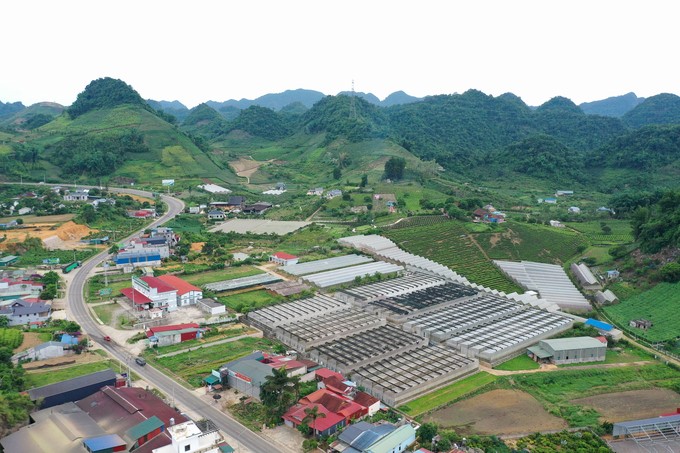November 27, 2025 | 23:54 GMT +7
November 27, 2025 | 23:54 GMT +7
Hotline: 0913.378.918
November 27, 2025 | 23:54 GMT +7
Hotline: 0913.378.918

Vast agricultural product area on the Moc Chau plateau. Photo: Hoang Anh.
Moc Chau district has an area of more than 10,300 hectares of fruit trees, including 3,710 hectares of plum trees, 1,771 hectares of longans, 1,556 hectares of mangoes, 548 hectares of apricots, 780 hectares of bananas, and 562 hectares of avocados. The annual output of fruits of all kinds reaches more than 61,508 tons. Thanks to that, Moc Chau is one of the localities that soon found an export route for fruits in Son La.
Mr. Tran Xuan Thanh, Head of the Department of Agriculture and Rural Development of Moc Chau district, shared: The district's goal is to focus on developing high-tech agriculture with the application of scientific and technical advances to diversify crop types and meet export market standards.
"The most important thing is to build standard raw material areas associated with the value chain and build the Moc Chau agricultural product brand. In recent years, in addition to plums, Moc Chau has developed many new fruit trees with very high economic value, such as strawberry, persimmon, orange, and Ha Den grape," Mr. Thanh affirmed.
Thanks to the application of scientific and technical advances, many fruit and vegetable models in Moc Chau have met standards to go to any market. Typically, safe vegetable models of all kinds in Dong Sang, Muong Sang, Tan Lap, and Phieng Luong communes reach VND 400-500 million/ha. The seedless orange model (Navel orange) reaches VND 600 million/ha; the high-quality plum model reaches VND 400-500 million/ha. The yellow-skinned dragon model in Moc Chau town reaches about VND 1.2 billion/ha; the Ha Den grape model reaches VND 4 billion/ha, etc.
In particular, Moc Chau, along with Son La province, is building a brand for strawberry, a crop that has been confirmed to have potential and advantages and is bringing high economic efficiency. As of now, the whole district has over 150 production facilities, including over 130 farmer households with an area of about 120 hectares and an average productivity estimated at 15 tons/ha. Along with that, the area of passion fruit, especially yellow passion fruit, is being expanded by businesses and cooperatives linking with farmers.

In addition to export-oriented production, many gardeners in Moc Chau also invest and attract tourists to visit and experience agricultural products. Photo: Quang Dung.
Mr. Nguyen Thach Tung Linh, Director of Loi Tuoi Agrico Moc Chau Co., Ltd., one of the pioneering businesses in linkage in Moc Chau, said: With a productivity of more than 50 tons/ha and the stable market price of around VND 100,000/kg, more and more Moc Chau people are becoming rich from yellow passion fruit. If production is organized well and standard raw material areas are built and linked with deep processing enterprises, passion fruit will certainly become the main export product of Moc Chau district.
Talking to Vietnam Agriculture Newspaper, the leader of Son La Department of Agriculture and Rural Development affirmed that the province is building synchronous solutions to increase the value of agricultural products. Of which focus on a number of solutions, such as supporting the building and development of export agricultural product brands through the National Brand Program and registering trademark protection for the province's key agricultural products domestically and internationally.
Along with that is improving the operational efficiency of connection and promotion systems for agricultural product consumption; diversifying the distribution and consumption channel system to ensure sustainability and stability, with priority given to the development of e-commerce.
Developing the agricultural product processing industry and service industries in rural areas; prioritizing support for the province's advantageous products that are eligible for export. Increasing the proportion of deep processing to reduce costs and increase the value of agricultural products.
Besides, another policy of Son La's agricultural sector is to form a number of industrial and service zones and clusters to serve agricultural production (warehouses, wharves, yards, processing plants, stations, hatcheries, etc.) by linking production areas with processing and trade.
In the coming time, Son La will continue to pay attention to attracting investment to improve processing and preservation capacity and logistics services for the main specialized farming areas, focusing on the province's key agricultural products.
Translated by Thu Huyen

(VAN) After the institutional merger, Da Nang possesses significant forest-carbon reserves and is proactively engaging in the carbon market, creating a new revenue stream.

(VAN) An Giang strengthens communication against IUU fishing, increases inspections and sanctions, and is determined to remove the EC’s “yellow card” while developing a sustainable fisheries sector.

(VAN) As green transition becomes a global trajectory, Viet Nam’s biggest challenge is not only technology and models, but how to ensure that capital flows reach the right beneficiaries.

(VAN) The Ministry of Agriculture and Environment must spearhead the construction of green governance, spanning decision-making processes and investment standards to policy evaluation mechanisms.

(VAN) The Agriculture and Environment sector of Khanh Hoa has achieved numerous milestones over the past 80 years, contributing significantly to the goal of establishing the province as a centrally governed city by 2030.

(VAN) Viet Nam is entering the pivotal period of 2025-2030, moving toward the formulation of the Remote Sensing Law, which will establish a legal foundation for the development of national digital data.

(VAN) The agricultural sector is finalizing the strategic framework for emission reduction, setting the goal of sharply cutting methane and 403.7 million tons of CO2 equivalent and moving toward Net Zero by 2050.